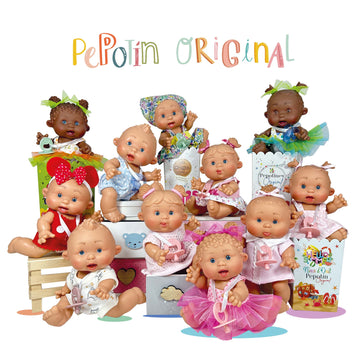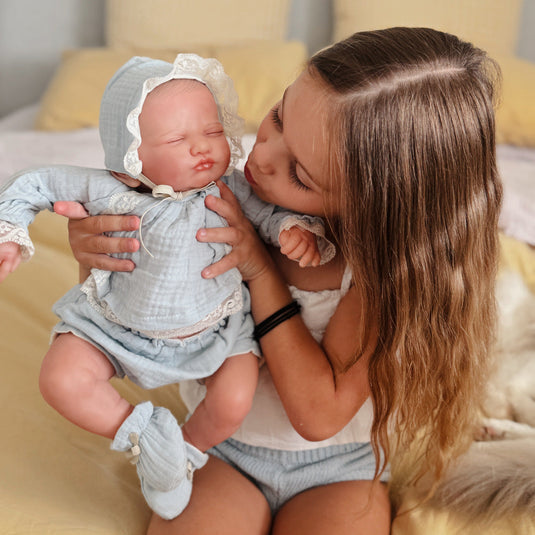Top Guidelines Of Dolls And Accessories
Top Guidelines Of Dolls And Accessories
Blog Article
Some Known Factual Statements About Dolls And Accessories
Table of ContentsSome Known Details About Dolls And Accessories The Of Dolls And AccessoriesGetting My Dolls And Accessories To WorkThe smart Trick of Dolls And Accessories That Nobody is DiscussingDolls And Accessories Can Be Fun For AnyoneThe Best Strategy To Use For Dolls And AccessoriesThe Of Dolls And Accessories
When dolls are consisted of in group play, kids exercise waiting, sharing, and listening to others' ideas. Whether they're pretending to be a parent, brother or sister, or pal, youngsters discover exactly how partnerships workhow to sustain others, address disputes, and look after someone else. These very early role-play experiences come to be the groundwork for healthy friendships and relationships later on in life.Duplicating soothing regimens with a doll (feeding, rocking, closing) can help children really feel tranquil and safe and secure. These comforting routines show them how to self-regulate. Caring for a doll can make a youngster feel qualified and certain - doll clothes. It gives them a sense of duty and control in a world that often feels unforeseeable.
The Main Principles Of Dolls And Accessories
When kids see dolls that mirror their race, heritage, and culture, it enhances a positive feeling of identity. Dolls additionally introduce youngsters to cultures outside their own, developing considerate curiosity and empathy for others.
As Dr. Karyn Purvis, a leader in child development and trauma-informed treatment, as soon as said: This effective quote highlights exactly how play isn't just funit's how youngsters learn best. The brain cables itself via rep. But when a kid is involved, joyous, and mentally attached to an activitylike doll playthe brain strengthens those links quicker and much more meaningfully.
Not known Factual Statements About Dolls And Accessories

Children need empathy, kindness, and creative imagination tooand doll play offers that. Dolls are frequently a kid's first "friend," aiding them practice relationships, develop communication skills, and really feel comforted.
8 Easy Facts About Dolls And Accessories Shown
Via play. Through satisfaction. Through dolls that matter. Thanks for joining us on this journey. Samantha Ong Samantha Ong is the creator of Joeydolls, a Canadian-based plaything brand on an objective to commemorate Eastern societies via cheerful, inclusive play. Influenced by her very own experiences expanding up without cultural depiction, Samantha develops dolls that assist children feel pleased with who they are while sparking inquisitiveness and compassion in others.
Playing with dolls urges kids to talk more concerning others' thoughts and emotions, a study has located. The research study recommends that playing imaginary games with dolls can help kids develop social skills, theory of mind and compassion. The neuroscientist that led the job stated that the academic value of having fun with Lego and building playthings was widely accepted, yet the advantages of playing with dolls in some cases showed up to have actually been overlooked."When kids produce fictional globes and function play with dolls, they communicate at very first aloud and after that internalise the message have a peek at these guys about others' ideas, emotions and sensations," said Dr Sarah Gerson, a neuroscientist at Cardiff University and the lead author.
Dolls And Accessories Fundamentals Explained
They were additionally more probable to address the dolls in the second individual, speaking to them directly, whereas the characters on the computer display they often tended to refer to in the third individual. No distinction was observed between children and women."Internal state language can indicate that a youngster is considering other individuals's ideas and feelings while having fun with dolls," claimed Gerson.
Which they see language use hereof is great confirmation of the theory."Mardell included that the searchings for ought to use to any type of sort of role-play plaything, rather than being specific to Barbies. "I would certainly take a broader view of what a doll is," he said." [Maybe] any kind of object that the child can spend a sense of various other right into a packed animal, a stove mitt that speaks with them, or even an imaginary pal."Children commonly start to reveal signs of inner state language around the age of four.
4 Easy Facts About Dolls And Accessories Shown
"It becomes vital for making and sustaining friendships, and how they pick up from their teachers, and parents."The research additionally located that the youngsters had increased mind task in the posterior superior temporal sulcus (pSTS) region when they spoke as though their dolls had thoughts and feelings. The pSTS region is thought to be entailed in the growth of social and emotional processing skills.
Childhood years is not a fixed life stage; indeed, the definition, definition and understanding of childhood years are all based on adjustment. By the 19th century one of the most profound modifications was the importance put on enabling kids to experience "the carefree pleasures" of childhood with playtime activities. Play was now considered to be a crucial component of an excellent childhood years.
In order to totally comprehend the meaning of play, one need to additionally understand the significance of the doll. Nonetheless, dolls are a lot more than playthings designed to captivate girls. Throughout the nineteenth century appropriate playtime activities were selected to promote intellectual, physical or psychological growth. Dolls were specifically prominent because they were thought to promote and support feminine qualities such as kindness, caring and compassion.
Excitement About Dolls And Accessories

It is just through archaeological investigations that scientists can really hope to discover and document the full series of play experiences. Narrating these experiences, and specifically the duty of dolls, is crucial for providing an extra total image of childhood during the nineteenth century. Alarcn, Sara E - dolls., "Child's Play: The Duty of Dolls in 19th Century Childhood" (2007 )
Report this page